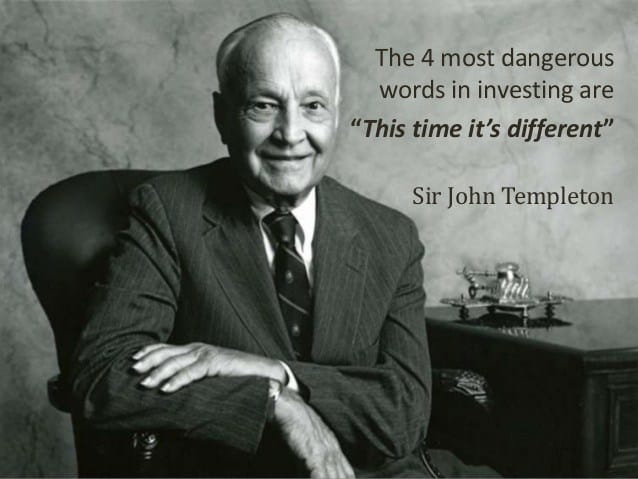Gold & Gold Mining - It's Different This Time
Following a conversation with Duncan MacInnes of The Ruffer Investment Company.
Let me tell you something you already know. The world ain't all sunshine and rainbows. It's a very mean and nasty place, and I don't care how tough you are; it will beat you to your knees and keep you there permanently if you let it. You, me, or nobody is gonna hit as hard as life. But it ain't about how hard you hit. It's about how hard you can get hit and keep moving forward; how much you can take and keep moving forward. That's how winning is done. Rocky Balboa.
Investing alongside maverick entrepreneurs like Ami Daniel at Windward, who build long-term value, offers potential high returns with the benefit of asymmetric risk. A fully invested founder at the helm affords focused domain knowledge and some downside protection.
However, successful investing also involves knowing when and how to protect capital more fully. As Morgan Housel noted, making money and keeping money require different mindsets. While timing the market is ill-advised, shifting from a risk-on to a risk-off mindset can add value.
As Housel puts it,
Getting money requires taking risks and being optimistic. Keeping money requires the opposite – humility and fear that what you have made can be taken away from you just as easily.
We have evolved to be risk-averse for good reason. Over recent decades, to its significant cost, Intel forgot founder Andy Groves' aphorism that "only the paranoid survive." However, Nvidia CEO Jensen Huang picked up Groves' baton when telling staff I don't wake up proud and confident. I wake up worried and concerned.
Later, he told a somewhat stunned group of high-achieving Stanford students,
People with very high expectations [like you] have very low resilience, and unfortunately, resilience matters in success ... I [therefore] wish upon you ample doses of pain and suffering.
Huang's operating philosophy of perpetual paranoia drove Nvidia's remarkable resilience and adaptability through its thirty-year evolution in the ruthlessly competitive and dynamic semiconductor industry. Last year, Nvidia's reward emerged as an apparent overnight success. It wasn't.
So complete is Nvidia's stranglehold on the building blocks of AI it took just six weeks this summer for its market value to increase by a trillion dollars to $3tn. At the same time, Warren Buffet's snail-like Berkshire Hathaway crossed the $1tn valuation threshold for the first time in its 63-year history of steady growth.
I recently spoke to Duncan McInnes, the Ruffer Investment Company (RIC) fund manager. Duncan is a macro-informed value investor whose go-anywhere investment mandate is to deliver consistent positive returns regardless of financial market conditions. Simple to say but tricky to achieve. As a result, Duncan has constructed a portfolio unlike any other.
Duncan's career was born in the storm of the 2008/9 GFC, and its scars helped form his investment philosophy and approach to risk. He said it taught him early on that nobody has a clue what's going on in financial markets, and therefore, humility amidst such uncertainty is essential.
As a raw graduate at Barclays looking at a client portfolio ravaged by the harsh market drawdown in late 2008, Duncan noticed a holding in a Ruffer fund that was up over the period. This chance observation eventually led him to become the RIC fund manager. As he said, if you filter funds by who made money in 2008, you'll get a list dominated by permabears. But if you filter it again by who also made money in 2009, the year of recovery, you get a much smaller list. The Ruffer Investment Company is on that list.
The Ruffer style mixes growth and protection assets, altering the mix to exploit changing macro conditions and market movements. Duncan looks for what he calls ugly ducklings (value) but also for protective positions in FX (the yen), volatility (the VIX), equity risk premia (credit spreads), and inflation (TIPs), which he calls oblique hedges. His search for asymmetric opportunities led him to buy Bitcoin in 2020, exiting for a significant return the following year.
For Duncan, global markets currently discount widely varying outlooks. Anomalies that he is keen to exploit. In short, he sees Treasury Bonds, oil, copper and Chinese equities as pricing in recession. However, looking at US equities, credit spreads, and volatility, it's all sunshine and rainbows.
Unsurprisingly, his fund is long the things discounting recession and not exposed to or hedged against the things illuminating sunshine and rainbows.
However, he says if one asset in his portfolio currently reflects the Ruffer worldview, it is gold. Duncan's portfolio is overweight gold and gold mining companies, but he concedes that gold does not look cheap. Indeed, gold is historically expensive, measured against oil, copper and real yields. Is he about to fall for what legendary investor Sir John Templeton said were the four most dangerous words in investing?
Although he is wary of saying this time it's different, he essentially says things are different this time for gold.
As he says, this time,
There is more geopolitical instability than we've seen in decades; inflation has gone from a hypothetical problem to a real problem, and new gold buyers have emerged because of the confiscation of Russian assets in the Western banking system in February and March 2022.
The People's Bank of China, other sovereigns, and individual "bad actors" keen to shed US dollar exposure have been buying ounces and lots of them. Meanwhile, with Western investors crowded into the Mag Seven, gold ETFs have seen outflows since the lockdown period when the gold price first went through $2000/oz.
Despite moving to new all-time highs, gold, in Duncan's view, counterintuitively, remains under-owned by institutional and private investors. He points out that the BoA asset manager survey shows that 75% of multi-asset fund managers have 1% or less exposure to gold, even more under-owned than UK equities!
So, is it right to buy gold at its new all-time high of $2,580/oz? There is another way.
Look at the MSCI World Index for gold mining companies from 2011. It is down 40%. Now, look at the gold price over the same period. It is up 70%.
Either the stock market is saying the gold price is not sustainable at these higher levels, or as Duncan describes it,
A huge crocodile jaw has opened up, making the mining companies look interesting.
We know Duncan is predisposed to bearishness, and gold is the ultimate safe asset. He admits that,
My view, rather than the Ruffer view, is that when I look at gold and the narrative around it, it is so perfect for the moment and the path of the economy that we see in the coming years that I think everyone might suddenly realise this is the perfect asset, and I don't own it. There's a decent chance that this cycle ends and in a massive gold bubble.
Last week, while most investors focused on the gyrations of Nvidia (it was up 15% or more than two AstraZeneca's worth), AngloGold Ashanti announced an agreed £2bn cash and shares offer for London-listed gold miner Centamin vindicating Duncan's view that if you want to own ounces, it is better value to buy gold miners than dig the stuff out of the ground or buy gold bars.
Here is a sneak preview of my conversation with Duncan MacInnes.
For disclosure, I own shares in The Ruffer Investment Company, gold and units in the VanEck Junior Gold Miners ETF.
Never investment advice, just the meandering thoughts of an old man trying to preserve some capital and maybe some dignity.







